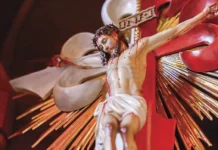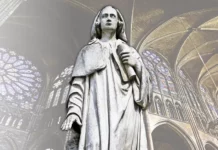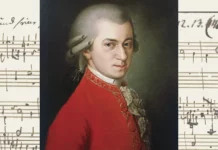Among the almond sweets, prepared with chocolate, liqueur and multi-coloured sugar, there is a very inviting offering which, due to its special flavour and symbolism, is never refused by visitors: the Easter Folar.
It is Easter day. You can hear the pealing of the bells from the top of the church steeples and the vibrant echo of the hand bells announcing the Lord’s Resurrection.
Among the various customs by which the different peoples celebrate Easter, a Portuguese tradition known as the Easter Compasso stands out.
A traditional Portuguese procession
The term compasso is a shortened form of the Latin expression “Crux cum passo Domino,” which means “Cross upon which the Lord suffered.” The word denotes a tradition that consists of a visit made by the parish priest to homes at Easter time, carrying a crucifix, to impart his blessing on the families. This is a very old custom, dating back to the Middle Ages, as evidenced by a document from the year 1357, preserved in Coimbra.1
The Compasso procession is led by the priest or, in his absence, by a designated substitute known as the juiz da cruz – the judge of the cross. He carries the processional crucifix of the parish, which on that day is decorated with flowers and white ribbons to symbolise the joys of the Resurrection. Immediately behind follows the “little cauldron” containing holy water to sprinkle the houses. Finally come the ringers, who make their bells resound in the streets, squares and alleyways, inviting families of faith to open the doors of their homes and hearts to the One who offered Himself for us on the wood of the Cross.
The procession of purple and white cloaks enters each house, causing a veritable shudder of emotion as they announce, “The Lord is risen, alleluia, alleluia!” Then the members of the family are invited to venerate Christ crucified, whom they kiss with great devotion. It is not unusual for some of them to have travelled from a distance, among the various smaller “Portugals”, to join the family patriarch and participate with him in this annual event.

Inviting and tasty delicacies
At the farewell, the owner of the house offers, besides a gift for the Church, something from his colourful table to the valiant messengers. Among the almond sweets, prepared with chocolate, liqueur and multi-coloured sugar, there is a particularly inviting treat which, due to its special flavour and symbolism, is never refused by the visitors: the Easter Folar [cake].
Initially called folore, over time it became known as folar, a name it retains to this day. It is part of traditional Portuguese cuisine, and there are countless variations of its recipe spread over the country’s eighteen districts and eleven islands. It can be sweet or savoury, contain spices, ham or cheeses… But there is one characteristic ingredient that is never missing: hard-boiled eggs placed whole in the dough.
How did this idea come about?

Between legend and history
The origin of this age-old tradition comes down to us through a legend. The story is told that Mariana, a young woman who felt called to start a family, prayed to St. Catherine of Alexandria to find a good Catholic husband who would be pleasing to God. She prayed with such faith that she found not one, but two young men who asked for her hand in marriage: a wealthy nobleman and an honest farmer named Amaro. After speaking separately with each, it was agreed that she would make a decision by Palm Sunday.
Before the stipulated deadline, however, the young woman learned that a feud had arisen between the suitors. She went to the place of the conflict and, when she cried out Amaro’s name to help him, her decision became clear: the farmer was her chosen spouse. However, on Easter day, when the wedding was already set, Mariana was very upset, for she heard a rumour that the nobleman was planning to appear at the wedding ceremony to kill her future husband.
Once again, Mariana turned to St. Catherine. She went to the altar dedicated to the Saint and there made her petition, leaving a bouquet of flowers at the feet of the statue. She was overjoyed to see her protector smiling at her! She returned home filled with confidence and found a new surprise: on the table was a large cake, made with whole eggs and encircled by flowers, the same flowers that she herself had placed on the altar.
She immediately went to tell Amaro the news and was amazed to find that he had received a similar cake… Believing that it must be a gesture from the nobleman, they went to his house to thank him. However, they discovered that he had also received the same cake! Mariana then realised that St. Catherine of Alexandria had used this tactic to bring about reconciliation on Easter Sunday.
Symbol of Christian unity and harmony
Thus arose the custom of preparing this treat, just as it was offered by St. Catherine, as a symbol of Christian unity. And when, following another ancient tradition, godchildren present their baptismal godmothers with bouquets of violets on the day of the Lord’s Resurrection, the latter thank them with a folar.
These special customs continue to the present day as a fruit of the Most Precious Blood of Our Lord Jesus Christ, whose five wounds hold such a special place in the Kingdom of Portugal’s origin.
Therefore, we invite our dear readers to participate in the Easter blessings by preparing a “folar” in their homes. And we hope that your entire family enjoys this tasty bread which is so symbolic of the true happiness and harmony that should exist among the children of the Holy Catholic Church. ◊
Easter Folar Recipe

Ingredients
500g (4 cups) flour / 10g (2 tsp) baker’s yeast / 50 ml (¼ cup) warm milk / 1 pinch of salt / 100g (½ cup) sugar / 75g (1/3 cup) butter / 3 eggs / zest of one orange / 1 teaspoon powdered cinnamon / 20 ml (4 tsp) brandy / 4 eggs boiled in water with onion skins.
Preparation
Pour a little of the warm milk into a small bowl, add the yeast along with two spoonfuls of flour and mix well. Let stand for ten minutes.
Transfer the milk with the yeast into a larger bowl, add the flour, salt, sugar, butter, two raw eggs, the orange zest, cinnamon and brandy. Blend all of the ingredients together, gradually adding the remaining milk, until the mixture is smooth.
Transfer to a well-floured surface, sprinkle with more flour and continue kneading until the dough is soft, elastic and no longer sticky. Throughout the process, sprinkle with flour as needed. Allow the dough to rise in a warm place, until doubled in volume.
Having set aside a small amount of dough for the finishing touches, place the rest on a buttered baking pan dusted with flour, in the shape of a flattened ball. Insert the hard-boiled eggs, whole in their shells, ensuring that they are set securely in place.
With the reserved portion of dough, make two long strips and place them on top of the cake, forming a cross. Beat the remaining egg in a small bowl, and brush it over the entire loaf. Place in oven heated to 350° F and bake for about thirty minutes until golden brown.
Notes
1 Cf. COELHO DIAS, Geraldo J. A. Origem medieval do Compasso – Visita Pascal. In: Lusitania Sacra. Lisboa. N.4 (1992); p.90.







